Great Design Plant: Dicentra Eximia Brightens Shady Gardens
http://decor-ideas.org 11/17/2014 03:13 Decor Ideas
Wild bleedingheart (Dicentra eximia) was the first plant that I put in when I began using native plants in my home landscape. Breaking soil in early April, it is one of the longest-blooming eastern North American native plants. After an initial flush of charming pinkish heart-shaped flowers, it continues blooming sporadically until fall. Finely divided foliage takes over after the flowers subside, providing contrast against large-leaved plants. It’s native to rich woodlands in the Mid-Atlantic region, and plants grown under similar conditions will flourish and spread by reseeding.
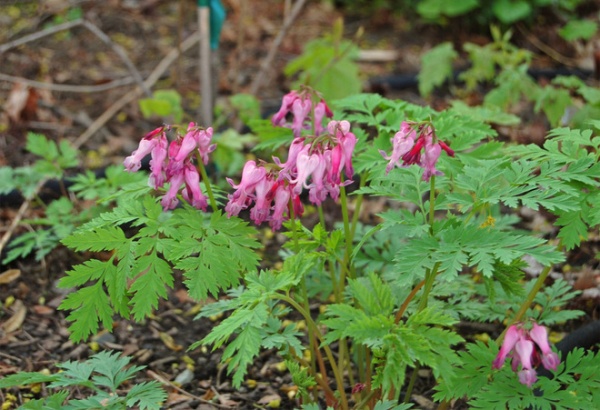
Botanical name: Dicentra eximia
Common names: Wild bleedingheart, turkey corn, fringed bleedingheart
Origin: Native from New Jersey and West Virginia south to Virginia and Tennessee, mostly in the Appalachian Mountains; has been found growing wild from Vermont to Georgia and west to Illinois
Where it will grow: Hardy to -40 degrees Fahrenheit (USDA zones 3 to 9; find your zone)
Shown: Wild bleedingheart’s pink hearts in mid-April
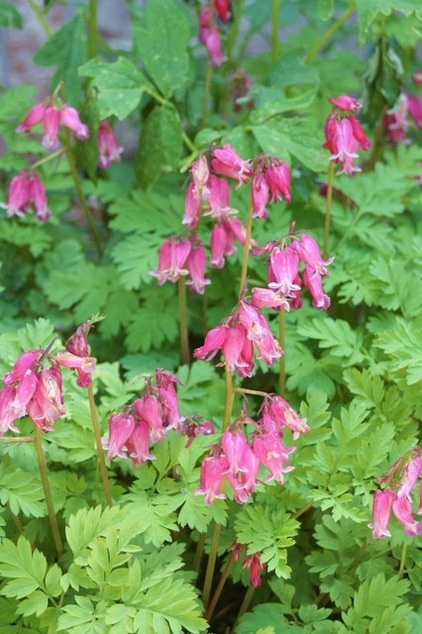
Water requirement: Prefers moist soil but will survive under drier conditions
Light requirement: Sun to shade; does best in partial sunlight or open shade; will tolerate more sun if the soil is kept moist
Mature size: 12 to 18 inches tall and wide
Benefits and tolerances: Resistant to deer and rabbit browsing; the foliage will look good all season in a shady location. I have grown this plant under the canopy of a Norway maple (dry shade) with good success.
Seasonal interest: Blooming is most intense in early to mid spring and will continue sporadically until fall; wild bleedingheart is among the first plants to leaf out in April and can have good-looking foliage well into fall
When to plant: Nursery-grown plants can be put in the ground anytime during the gardening season, though they fare better in spring or fall
Distinguishing traits. The flowers are like little pink hearts, dangling from a stem held just above the foliage. The flower color is typically pink or purplish pink but ranges from white to red. The foliage consists of finely divided leaflets arising from a short rhizome.
Photo by Patrick Standish
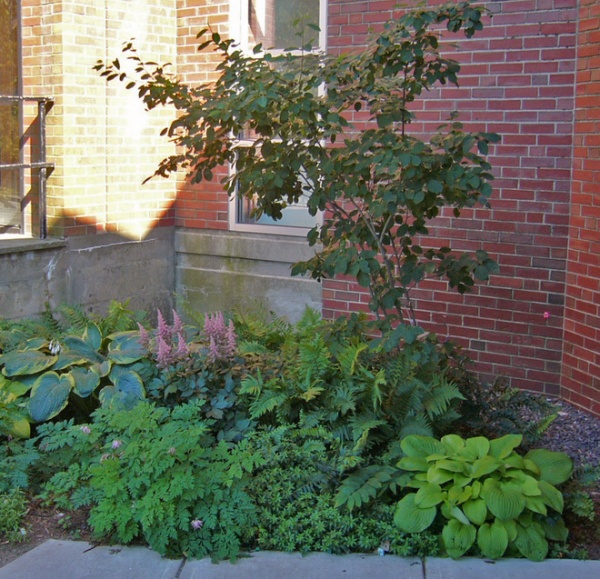
How to use it. In a shady garden, wild bleedingheart forms a dense, low mass of long-lasting foliage punctuated by dangling pink flowers. The fine texture of the foliage combines well with that of ferns and contrasts with that of broad-leaved plants like hosta and Bergenia. In a woodland garden, its tight, dense form means it serves well as a ground cover and along paths.
The small garden shown here was intended to calm. All of the plants have an arching form, but contrast is provided by the foliage textures and tones. Wild bleedingheart and sweet woodruff (Galium odoratum) provide the finest textures. The flower colors are limited to pink — with astilbe (Astilbe sp) and bleedingheart — and white — with hosta (Hosta sp) and sweet woodruff — to maintain the subtle nature.
Pollinator notes. Hummingbirds and long-tongued bumblebees pollinate wild bleedingheart. The bees grab onto the appendages at the bottom end of the flower and stick their heads inside the corolla (group of petals) to collect nectar. In the process they rub their bodies against the reproductive flower parts that protrude from the end of the blossom.
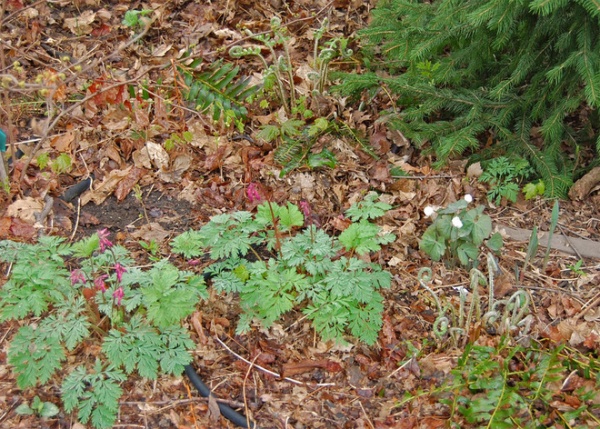
Planting notes. Bleedingheart prefers rich, moist soil, but it will grow under drier conditions. It spreads slowly by rhizomes but will grow vigorously by reseeding into good soils. Plants in too much sun will look ragged later in the season. Plants do not grow well in sandy, low-organic content soils.
Propagate by planting fresh seeds. Any seed held for a time must be kept moist. Germinate seeds by alternating warm, cold and warm periods of stratification to get good results. In nature ants assist with seed dispersal. The seeds have a lipid-rich coating, which the ants eat. They collect the seeds and store them underground in their nest. After eating this coating, the ants discard the seed in the “trash,” essentially sowing the fresh new seed. Overall it may be easiest to transplant the self-seeded plants. After four to five years, mature clumps may be divided in early spring.
Shown: This photo shows that blooming starts very early, while ferns and other plants like Bellwort are just breaking out. Twinleaf (Jeffersonia diphylla) is another early-blooming native species. These particular plants are located under a Norway maple and have been slowly spreading for over five years.
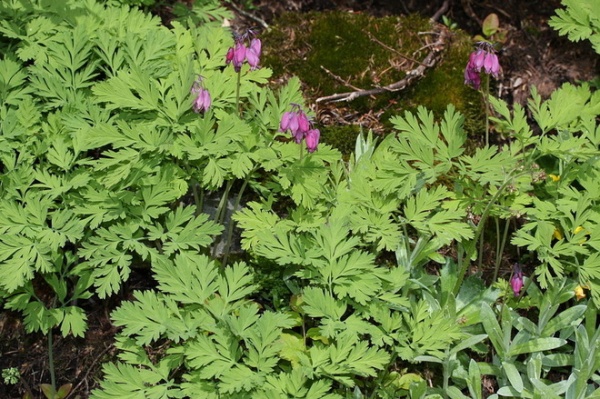
Pacific bleedingheart (Dicentra formosa), shown here, is native to the western coast of North America from Canada to Northern California. Its foliage has more of a blue-green cast than that of its eastern relative. It likes similar growing conditions but spreads more aggressively via rhizomes.
Many of the commercially available cultivars of bleedingheart are actually hybrids of D. eximia and D. formosa.
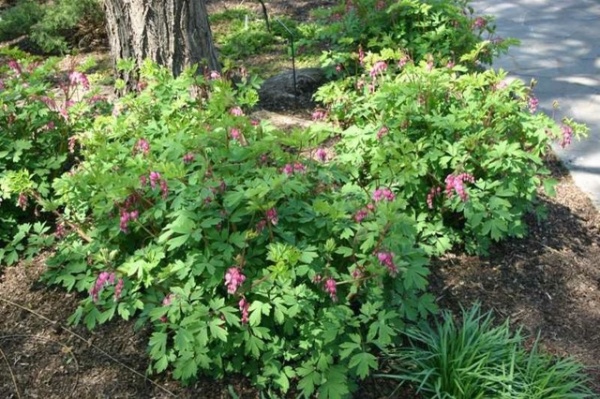
This cultivar, named ‘Luxuriant’, is a hybrid species, though its exact parentage is unclear to me. Some D. formosa and D. eximia hybrids include ‘Bacchanal’, ‘Bountiful’ and ‘Stuart Boothman’. There are also more complex hybrids with the Asian species D. peregrina, such as ‘King of Hearts’.
Not all bleedinghearts are pink. ‘Ivory Hearts’ is a white-flowered hybrid. D. ‘Alba’ (or D. eximia var. alba) is a white form of the species. Pacific bleedingheart also has a white version, D. formosa sp. oregana.
More: Browse plants native to more regions of the U.S.
Related Articles Recommended












